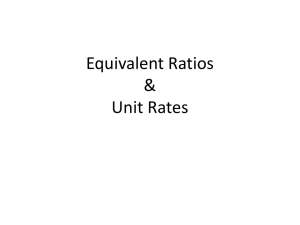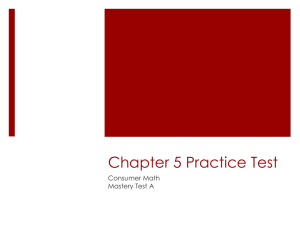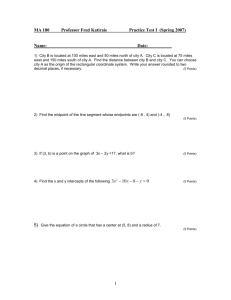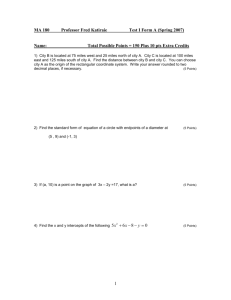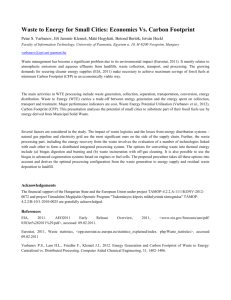9-12 Environmental Science
advertisement
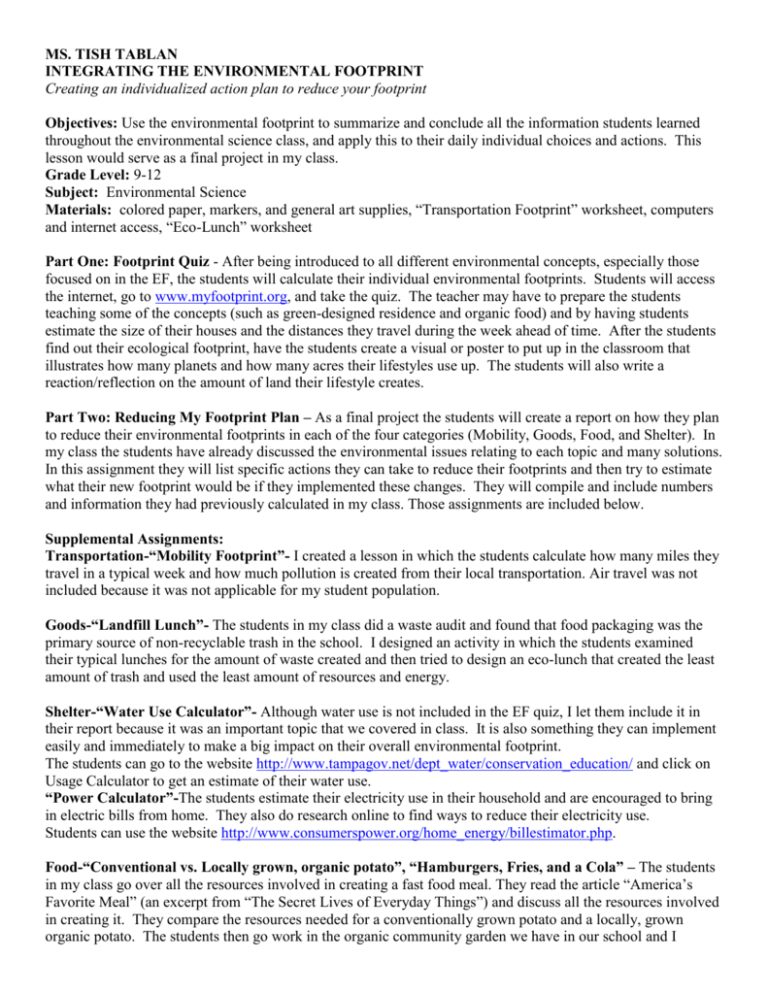
MS. TISH TABLAN INTEGRATING THE ENVIRONMENTAL FOOTPRINT Creating an individualized action plan to reduce your footprint Objectives: Use the environmental footprint to summarize and conclude all the information students learned throughout the environmental science class, and apply this to their daily individual choices and actions. This lesson would serve as a final project in my class. Grade Level: 9-12 Subject: Environmental Science Materials: colored paper, markers, and general art supplies, “Transportation Footprint” worksheet, computers and internet access, “Eco-Lunch” worksheet Part One: Footprint Quiz - After being introduced to all different environmental concepts, especially those focused on in the EF, the students will calculate their individual environmental footprints. Students will access the internet, go to www.myfootprint.org, and take the quiz. The teacher may have to prepare the students teaching some of the concepts (such as green-designed residence and organic food) and by having students estimate the size of their houses and the distances they travel during the week ahead of time. After the students find out their ecological footprint, have the students create a visual or poster to put up in the classroom that illustrates how many planets and how many acres their lifestyles use up. The students will also write a reaction/reflection on the amount of land their lifestyle creates. Part Two: Reducing My Footprint Plan – As a final project the students will create a report on how they plan to reduce their environmental footprints in each of the four categories (Mobility, Goods, Food, and Shelter). In my class the students have already discussed the environmental issues relating to each topic and many solutions. In this assignment they will list specific actions they can take to reduce their footprints and then try to estimate what their new footprint would be if they implemented these changes. They will compile and include numbers and information they had previously calculated in my class. Those assignments are included below. Supplemental Assignments: Transportation-“Mobility Footprint”- I created a lesson in which the students calculate how many miles they travel in a typical week and how much pollution is created from their local transportation. Air travel was not included because it was not applicable for my student population. Goods-“Landfill Lunch”- The students in my class did a waste audit and found that food packaging was the primary source of non-recyclable trash in the school. I designed an activity in which the students examined their typical lunches for the amount of waste created and then tried to design an eco-lunch that created the least amount of trash and used the least amount of resources and energy. Shelter-“Water Use Calculator”- Although water use is not included in the EF quiz, I let them include it in their report because it was an important topic that we covered in class. It is also something they can implement easily and immediately to make a big impact on their overall environmental footprint. The students can go to the website http://www.tampagov.net/dept_water/conservation_education/ and click on Usage Calculator to get an estimate of their water use. “Power Calculator”-The students estimate their electricity use in their household and are encouraged to bring in electric bills from home. They also do research online to find ways to reduce their electricity use. Students can use the website http://www.consumerspower.org/home_energy/billestimator.php. Food-“Conventional vs. Locally grown, organic potato”, “Hamburgers, Fries, and a Cola” – The students in my class go over all the resources involved in creating a fast food meal. They read the article “America’s Favorite Meal” (an excerpt from “The Secret Lives of Everyday Things”) and discuss all the resources involved in creating it. They compare the resources needed for a conventionally grown potato and a locally, grown organic potato. The students then go work in the organic community garden we have in our school and I encourage them to start gardens in their own homes and communities. REDUCE MY FOOTPRINT FINAL PROJECT OUTLINE TOTAL FOOTPRINT: Describe your total footprint, and how many planets we would need List what your footprint was for each category. Explain what your biggest category was and why you think that was the biggest What is your overall goal to reduce your footprint to (in acres or number of planets)? How did you come up with that number? FOOD: Write a paragraph that describes your food footprint and the areas you need to improve the most in. Here are some topics you can address, but you must give at least 4 detailed examples of what exactly you would do to reduce your footprint in this area. How often you eat animal products What do you with food waste How much the food is processed and packaged How far away the food travels to get to you or where the food comes from What chemicals are used on the food or in the soil How often you throw away uneaten food TRANSPORTATION/MOBILITY: Write a paragraph that describes your transportation (or mobility) footprint and the areas you need to improve the most in. Here are some topics you can address, but you must give at least 4 detailed examples of what exactly you would do to reduce your footprint in this area. Number of miles you ride in a car per week Number of miles you ride in a bus per week Amount of gas used per week Amount of air pollution created from transportation per week How many people ride in your car How fuel efficient your car is How far and how often you ride in a plane SHELTER/ENERGY USE: Write a paragraph that describes your shelter footprint and what areas you need to improve the most in. Here are some topics you can address, but you must give at least 4 detailed examples of what exactly you would. Use ideas from Eco-Home and from the California ScienCenter exhibits The energy efficiency of house How many people live in the house What kind and how many appliances and electronics you have How often you use appliances and electronics How your house is heated, cooled, and insulated What type of lighting you have and how often you use it What type of energy source your electricity comes from Water efficiency inside and outside the house What type of plants, lawn, and garden you have Water efficiency in lawn and garden GOODS/SERVICES: Write a paragraph that describes your shelter footprint and what areas you need to improve the most in. Here are some topics you can address, but you must give at least 4 detailed examples of what exactly you would. How an item is packaged and how to dispose of packaging What the items are made of and how the item can be disposed of How many toxic materials or chemicals are in the product If you really need the product What you do with products when you are “done” with them MOBILITY FOOTPRINT What is the impact you make on earth from your weekly transportation needs? 1. Calculate the miles you travel by CAR each DAY. Go to www.mapquest.com. Multiply the distance between two places by 2 to calculate the round-trip mileage. CAR Miles/day 2.Calculate the miles you travel by CAR each WEEK. Multiply your answer to #1 by 7. CAR Miles/wk 3. Find out what the gas mileage is for the car that you usually drive in. Go to www.fueleconomy.gov to look up your car. Miles/gallon 4. Calculate how many total miles passengers get from your car trips. Multiply your answer to #3 by the number of people that usually ride in the car. Multiply by 1 if you ride by yourself usually. Total Passenger miles/gallon 5. Calculate how many gallons of gas you personally use from your weekly CAR trips. Divide the answer #2 (car miles/wk) by the answer to #4 (passenger miles/gall). Gallons/week by car 6. Calculate how many pounds of pollution (carbon dioxide) is put into the air from your weekly travels. Since each gallon of gas used gives off 18 pounds of carbon dioxide, Multiply the answer to #5 by 18. Pounds of air Pollution/week CAR FOOTPRINT BUS FOOTPRINT 1. Calculate the miles you travel by BUS each DAY. Go to www.mapquest.com. Multiply the distance between two places by 2 to calculate the round-trip mileage. BUS Miles/day 2.Calculate the miles you travel by BUS each WEEK. Multiply your answer to #1 by 7. BUS Miles/wk 3. The gas mileage for an average city bus is lower than cars, but it makes up for it by carrying so many people. Buses average 4 miles per gallon 4 Miles/gallon 4. Calculate how many total miles passengers get from your bus trips. Since buses can fit up to 35 passengers, Multiply the bus’s gas mileage (4 mpg) by 35. Total Passenger miles/gallon 5. Calculate how many gallons of gas you personally use from your weekly BUS trips. Divide the answer #2 (car miles/wk) by the answer to #4 (passenger miles/gall). Gallons/week by bus 6. Calculate how many pounds of pollution (carbon dioxide) is put into the air from your weekly travels. Since each gallon of gas used gives off 18 pounds of carbon dioxide, Multiply the answer to #5 by 18. Pounds of air Pollution/week WEEKLY TRANSPORTATION POLLUTION 1. Calculate the total amount of gas used per week. Add together both answers to #5 Weekly gallons used 2.Calculate the total amount of air pollution created per week from transportation. Add together both answers to #6. Weekly pounds of Air pollution made Landfill Lunch USUAL LUNCH Description Points LUNCH CONTAINER How much waste does your lunch create? DIRECTIONS: In our school, food packaging creates more than half of all trash. You can help reduce the total trash created at our school by reducing the trash in your own lunch. MAIN MEAL SIDE DISH DRINK In the first chart describe your usual or typical lunch. Describe the container that you would use or the trash involved for each part of your lunch. NAPKINS, SILVERWARE, CONDIMENTS TOTAL POINTS ECO-LUNCH Description LUNCH CONTAINER MAIN MEAL SIDE DISH DRINK NAPKINS, SILVERWARE, CONDIMENTS TOTAL POINTS 5 points: REDUCE (no container or material used) 4 points: LONG REUSE (lasts more than 1 year) 3 points: SHORT REUSE & RECYCLE 2 points: SHORT REUSE (lasts less than 1 year) 1 point: RECYCLE ONLY 0 points: TRASH (goes to a landfill) Points In the second chart you are going to design the most trashfree lunch you can that also uses the least amount of energy, resources, and trash. If you can eliminate the container completely, that earns the most points. The more you can reuse the container, the more points you earn. Only recycling earns very few points, and trash earns no points. The student that earns the most points and can create the most ecofriendly lunch will get rewarded!! WATER USE CALCULATOR (Copied from http://www.tampagov.net/dept_water/conservation_education/) GENERAL QUESTIONS 1. Total number of people in your household. (Required) INDOOR WATER USE BATHROOM 1. How many showers are taken each day in your household? 2. What is the average length (in minutes) of each shower. Enter 6.3 if you are unsure. 3. What is the flow rate (gallons per minute) of your showerhead? Enter 5 for standard showerhead; 2 for low flow. 4. Total number of baths taken each week by members of your household. TOILETS 1. Average number of times each person flushes a toilet in your house per day. Enter 4 if you are unsure. 2. How many gallons does your toilet use per flush? Enter 5 if you have a standard toilet; 1.6 if you have a low volume toilet. FAUCETS 1. How many times each day does each household member use faucets to shave, brush teeth, wash hands and face? 2. How many minutes does the water run during each use? WASHING DISHES 1. How many times are dishes washed by hand each day? 2. How many minutes does the water run during each wash? 3. If you have a dishwasher, how many times is it used each week? 4. The average dishwasher uses 15 gallons of water per load, change this if yours is different. LAUNDRY 1. How many loads of laundry are done by members of your household each week. 2. The average washing machine uses 55 gallons of water per load, change this number if yours is different. OUTDOOR WATER USE LAWN WATERING & OTHER USES 1. How many times is your lawn watered each week? 2. How many minutes is the lawn watered per watering? 3. Water is also used outdoors to wash cars, fill pools, rinse outdoor furniture and clean equipment. Estimate the average number of minutes water is used outdoors for purposes other than watering each week. Press the Calculate button to compute your overall water use. RESULTS PER CAPITA DAILY WATER USE IN YOUR HOUSEHOLD (gallons) INDOOR WATER USE OUTDOOR WATER USE Bathroom Lawn Watering Toilets Other Outdoor Uses Faucets GENERAL WATER USE Laundry Dishwasher Hand Washing Dishes Click one of the categories above to learn how to reduce your water usage. COMPARISON BETWEEN YOUR HOUSEHOLD AND THE TAMPA AVERAGE* HOUSEHOLD Your House Tampa Average Interior per capita gallons per day 64 Exterior per capita gallons per day 40 Total Per Capita Gallons of Water Used in the House Per Day Per Month Per Year Your Household Tampa Average Comments: *Based on Tampa Water Department data. POWER CALCULATOR (Copied from http://www.consumerspower.org/home_energy/billestimator.php) To calculate an estimated monthly electrical bill for your home, please select a QUANTITY in the applicable Electrically Powered Items field. Once you've filled out the fields that are relevant to your home, click the "Calculate" button at the bottom of this form. This will give you both an estimated monthly KWh usage and bill for your home (for an average family of four). KITCHEN Electrically Powered Items Quantity Average monthly KWh KWh/month $/month Refrigerator 182 Freezer 190 Dishwasher 60 Range / Oven 104 Microwave 16 Hot Water Dispenser 49 Coffee Maker 19 ENTERTAINMENT Electrically Powered Items Quantity Average monthly KWh Stereo 5 TV 19" 18 TV 25" 26.6 TV 35" 39.4 LAUNDRY Electrically Powered Items loads/week KWh/load Dryer Washing cold / cold Washing warm / cold Washing hot / cold Washing warm / warm Washing hot / warm KWh/month $/month KWh/month 3.12 0.33 3.0 5.0 6.0 7.0 $/month KWh/month $/month LIGHTING Electrically Powered Items Quantity Average monthly KWh Lighting # of Rooms 10 Outdoor Light 175 w 60 Outdoor Light 250 w 87 MISC. EQUIPMENT Electrically Powered Items Quantity Average monthly KWh Hot Tub Window Air Conditioner Ceiling Fan Electric Blanket 24" Box Fan Computer Water Bed Heater # of Water Heaters Water Heater (# of People) KWh/month 600 134 85 22 30.6 17.5 175 220 110 $/month Estimated monthly household* usage: kWh; Estimated monthly household* bill: Estimated monthly heating usage: kWh Estimated monthly heating bill: $ ESTIMATED MONTHLY KWh USAGE ESTIMATED MONTHLY BILL* $ * Monthly bill includes basic service charge and tiered usage discounts, where applicable. Estimates are based on national average.


